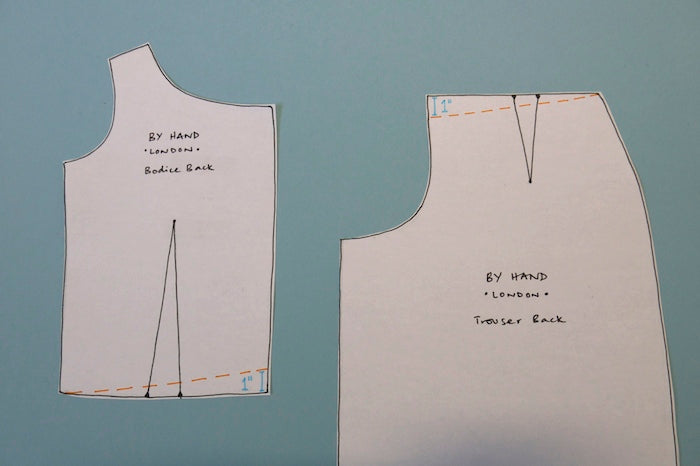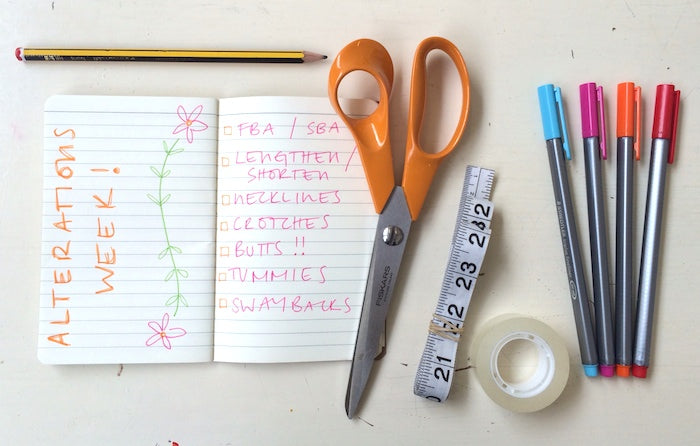Hellooooo and welcome back to Alterations Week (or Alterations Fortnight as it's turning out to be!) for the Holly Jumpsuit Sewalong! During Alterations Week we will be going through as many pattern alteration tutorials as we can physically crush in, making this our most comprehensive Sewalong yet! The extra great news is that a lot of these tutorials will be applicable not only to the Holly Jumpsuit, but to a huge amount of other patterns too as we tackle most of the common issues surrounding pattern fitting.
*To be taken to all the posts in the Holly Jumpsuit Sewalong, please click here!*
Today we'll be talking about how to alter a paper pattern for swaybacks. Sounds a little scary - at least it always has done to me! - but actually a very simple and straightforward alteration to make.
What you'll need:
- Your toile of the Holly Jumpsuit
- Your traced and cut out bodice back and trouser back pieces of the Holly Jumpsuit. Make sure you trace the pattern pieces according to your waistline measurement
- Tape measure
- Pens
- Paper scissors (not the fabric shears!)
- Extra paper
- Tape
Please note: We are using itty bitty replica's of the pattern pieces to illustrate the alterations as simply and clearly as possible - please make sure that you alter your real-life pattern pieces, complete with notches, pattern info and grainlines!
So what exactly is a Swayback? And how do I know if I have one??
A swayback is basically an exaggerated concave curve at the small of your back. It can be due to your posture, for example if you're a dancer or gymnast, or it could just be the natural shape of your spine.
If you have a swayback, you'll notice that garments often seem too long at the centre back, creating horizontal wrinkles where the excess fabric pools at the small of your back.

As with most fitting alterations, it's important not to mis-diagnose! Other fitting issues that could easily be misconstrued as a swayback include:
- Short torso/high waistline - if the horizontal folds extend around the front of the waistline as well as the back, or the entire waistline falls below your natural waist, try shortening the bodice first. A swayback will only be too long at the centre back, but should fit nicely at the centre front and side seams.
- Full bust - if you have a full bust, this will elevate the waistline at the front, probably causing it to droop down at the back and create those horizontal wrinkles. Try a full bust adjustment.
- Full or high butt - if you need more space in the ole buttock department, it could make the fabric near the waistline ride up and pool at the small of your back. By the same token, if you have a full butt and you've cut your jumpsuit to fit your hip measurement, chances are it will be too big at the back waistline. Try a full butt adjustment.
The good news is that altering your pattern for a swayback is really quick and easy! All we need to do is pinch out those unwanted folds and thereby shorten the centre back, without changing the side seams.
Step 1
Put on your toile and carefully pinch out the horizontal folds that occur across the small of your back. If you have a friend to help you out here, all the better. Pin the excess fabric in order to measure the amount by which you'll need to shorten the centre back.

Step 2
Now you can take off your toile and measure that unwanted excess.
For example, we pinched out about 2" of excess fabric at the centre back, sloping out to nothing at the side seams. As a result, we'll be taking out 1" from the centre back length at the bodice back, and taking out 1" from the centre back length at the trouser back.
Step 3
Take your traced bodice back piece and trouser back piece. Mark 1" up from the waistline (or down from the waistline in the case of the trousers) at the centre back. Now draw a smooth line from that 1" mark out to the side seam to create your new waistline (shown in orange).

Fold up your darts and then cut along the new waistline.
Tip from the top: Always check your adjustment by making another toile to check the fit. O nce you're happy with your newly adjusted pattern, copy it out onto some card for extra safe-keeping! Although this is an easy adjustment to make, no one wants to have to do it twice...




Comments on this post (4)
Hi Bridget, to transfer your newly adjusted pattern onto card, all you need to do is place the adjusted pattern pieces onto your card and trace around it, remembering to include all notches, darts, pattern info etc.
Hope this helps!
Elisalex
— Elisalex - By Hand London
What is the best method to copy your newly adjusted pattern to a card? Thank you
— Bridget Healy
Hi Chris, you won’t need to add any length to the trouser – all the excess fabric has come from the shape of the small of the back, and all you need to get rid of is what is collecting there. You haven’t removed any length from the side seams or the inseam, so the trouser leg length stays exactly the same. Hope this helps! x
— Elisalex - By Hand London
Should you add the excess length to the end of the trousers? You’ve just removed 2 inches from the back, won’t the legs be shorter?
— Chris Griffin